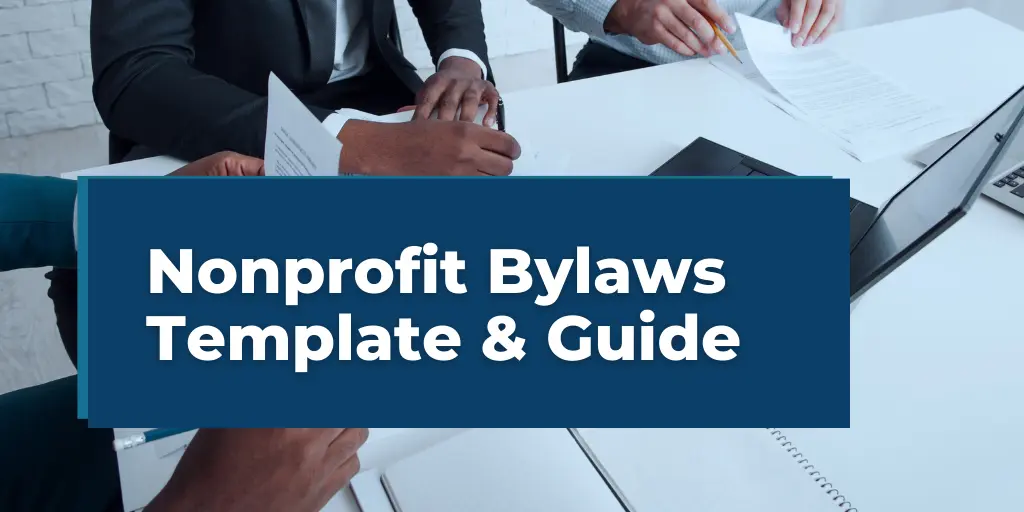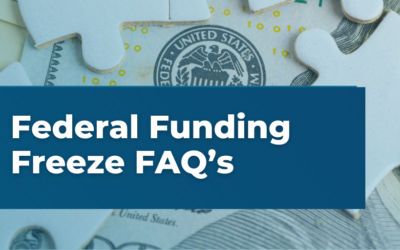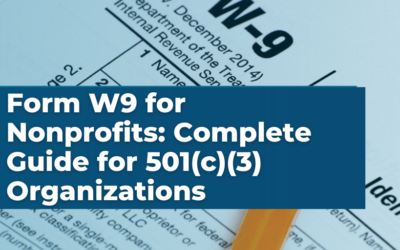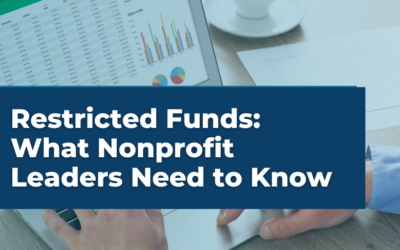In the heart of every well-run nonprofit organization lies a crucial document: the bylaws. Bylaws are more than just complicated documents; they’re the foundation that helps run everything smoothly. Nonprofit bylaws are formal written rules that govern the operations, decision-making processes, and organizational structure of a nonprofit organization.
Creating rules for a nonprofit involves more than just legal compliance. It also establishes decision-making processes, problem-solving methods, and future planning. Rules are essential for guiding your nonprofit operations and ensuring its long-term success. They provide structure, clarity, and consistency in how the nonprofit operates.
By setting clear rules, the nonprofit can effectively manage conflicts, address challenges, and achieve its goals. Even though writing or updating bylaws might seem daunting, this guide is here to make it easier. Whether you’re starting fresh or updating the rules for a current nonprofit, getting the bylaws right is crucial for doing well.
Building the Foundation with Bylaws
Bylaws are the backbone of any nonprofit organization, providing the necessary structure for governance and functional efficiency. Understanding these basic elements is crucial for creating a document that complies with legal requirements. It also assists with daily operations and a long-term strategic plan.
Defining Bylaws
- What They Are: Written rules that govern the nonprofit’s operations.
- Their Role: Serve as the primary governance manual for decision-making processes.
Importance of Bylaws in Governance
- Legal Necessity: Essential for compliance with state and federal regulations.
- Functional Framework: Offer a clear guide for conflict of interest, management, and organizational structure.
Key Components of Effective Bylaws
- Mission Statement: Clearly states the nonprofit’s purpose and goals.
- Board Structure: Includes details on the composition, responsibilities, and tenure of board members.
- Meeting Guidelines: Outlines the protocols for meeting frequency, agenda setting, quorums, and decision-making.
- Committee Functions: Specifies types of committees, their roles, and limitations.
- Officer Roles: Describes the responsibilities of nonprofit board members and election process for executive positions.
- Financial Management: Addresses fiscal policies, reporting practices, and asset distribution upon dissolution.
- Amendment Process: Details the procedure for updating and revising the bylaws to reflect organizational changes.
Understanding bylaws is key to creating a strong nonprofit that follows the rules and reaches its goals.
Key Components of Effective Bylaws
Creating strong bylaws is key to setting up your nonprofit’s governance. They not only meet legal requirements but also shape how your organization operates, makes decisions, and adapts. Understanding bylaws ensures your group functions smoothly and prepares for the future.
Board Structure and Governance
- Composition and Size: Determines the makeup and number of board members to ensure diverse representation and manageable nonprofit governance.
- Roles and Responsibilities: Outlines the duties of board members, providing clarity on expectations and accountability.
- Terms of Service: Specifies the length of service for nonprofit board members, promoting fresh perspectives over time.
Meeting Guidelines
- Frequency and Scheduling: Establishes how often the board meets to ensure regular oversight and decision-making.
- Procedural Rules: Sets the standards for conducting meetings, including notice requirements, agenda setting, and the process for making motions.
- Voting: Describe the voting process to ensure fairness. The goal is to have a sufficient number of members present for decisions and to have a clear process for voting.
Committee Functions
- Types and Roles: Describes the various committees (e.g., Executive, Finance, Nominating), their purposes, and responsibilities.
- Formation and Membership: Details how committees are formed, their size, and the selection of committee members.
- Authority and Limitations: Clarifies the powers granted to committees and any restrictions on their actions.
Officer Roles and Duties
- Executive Positions: Identifies key officer positions (President, Treasurer, Secretary, etc.), including their roles and functions within the organization.
- Election and Tenure: Describes the process for electing officers, their terms of service, and procedures for resignation or removal.
- Responsibilities: Outlines the specific responsibilities of board members, ensuring clear division of responsibilities and effective management.
Financial Management and Accountability
- Fiscal Policies: Addresses how the nonprofit will manage its finances, including budgeting, reporting, and audits.
- Asset Management: Details the procedures for handling the nonprofit’s assets, both during operation and in the event of dissolution.
- Transparency and Reporting: Specifies the requirements for financial transparency and accountability to stakeholders.
Amendment Process
- Procedure for Changes: Details how bylaws can be amended, including who can propose amendments and the process for approval.
- Flexibility for Growth: Ensures the organization can adapt its governance structure as it evolves, maintaining relevance and effectiveness.
Drafting Your Bylaws
Creating effective bylaws is critical for defining the nonprofit governance and blueprint. This section will help formulate bylaws that are clear, compliant, and conducive to your nonprofit organizations mission.
1. Legal and Mission Alignment
- Understand Legal Requirements: Research state and federal laws to understand the legal requirements for your nonprofit. Make sure you are compliant with these laws to maintain your tax-exempt status. Key areas include equality policies, purpose definition, and dissolution procedures.
- Define Mission: Articulate your nonprofit organizations mission within the bylaws to serve as a guide for all decisions. Detail your nonprofit’s main goals and activities, aligning them with the overarching mission.
2. Structure and Governance
- Board Composition and Governance: Determine the size and structure of your board. Take into account diversity, expertise, and stakeholder representation. Clearly outline the election process, term lengths, and the specific duties of board members to ensure effective governance.
- Committees and Officer Roles: Define the roles and responsibilities of key officers and committees. This explanation will detail how committees form and discuss their specific areas of focus, such as finance or governance. Additionally, it will outline the duties of officers like the Board President, Secretary, and Treasurer.
3. Operations and Meetings
- Meeting Protocols: Set a regular schedule for board meetings, including the procedure for special meetings. Establish how agendas are created and communicated. Create rules for making decisions, such as quorum requirements and voting procedures.
- Financial Oversight: Incorporate guidelines for budgeting, financial reporting, and asset management. These provisions should ensure accountability and transparency in financial matters.
4. Adaptation and Approval
- Amendment Procedures: Provide a clear process for proposing and approving changes to the bylaws.
- Review and Approval: Before finalizing, have your draft reviewed by a legal services counsel to confirm compliance and completeness. Detail the approval process, including board approval and any required meetings or votes.
Revising and Updating Your Bylaws
To maintain the effectiveness and relevance of your nonprofit, it’s crucial to review and update your bylaws. This ensures they align with your current operations, legal duties, and organizational goals.
Establish a Review Schedule
- Regular Reviews: Aim for a biennial review, involving nonprofit board members and legal counsel to identify necessary updates.
Evaluate and Propose Changes
- Identify Needs: Assess how organizational changes might require bylaw adjustments.
- Draft Amendments: Propose clear and legally vetted changes to address these needs.
Approval and Implementation
- Follow Procedures: Use the bylaws’ outlined process for making amendments, ensuring transparency and member involvement.
- Update and Educate: After approving changes, update the official document and brief the organization on the revisions.
Practical Tips for Bylaw Management
Managing bylaws well helps them guide your nonprofit effectively. Here are some tips for efficient bylaw management:
- Avoid Legal Jargon: Use clear, simple language to make your bylaws straightforward and easy to follow.
- Make Accessible: Keep bylaws easily available and go over important parts in meetings to ensure everyone understands them.
- Get Legal Advice: Seek assistance from a nonprofit lawyer to ensure legal accuracy.
Conclusion
Bylaws are your nonprofit’s rulebook, showing everyone how to work together and make choices. They keep your nonprofit corporation on track and running smoothly, not just for legal reasons but to achieve your goals.
As your nonprofit grows, your bylaws should too. Legal reviews, regular checks and updates are key. Managing your bylaws well strengthens and sharpens your focus.
If you’re unsure about your bylaws or think they need a refresh, now’s the time to review and adjust. Seek feedback from your team and consult for legal advice if necessary. This effort can boost your nonprofit’s success.





